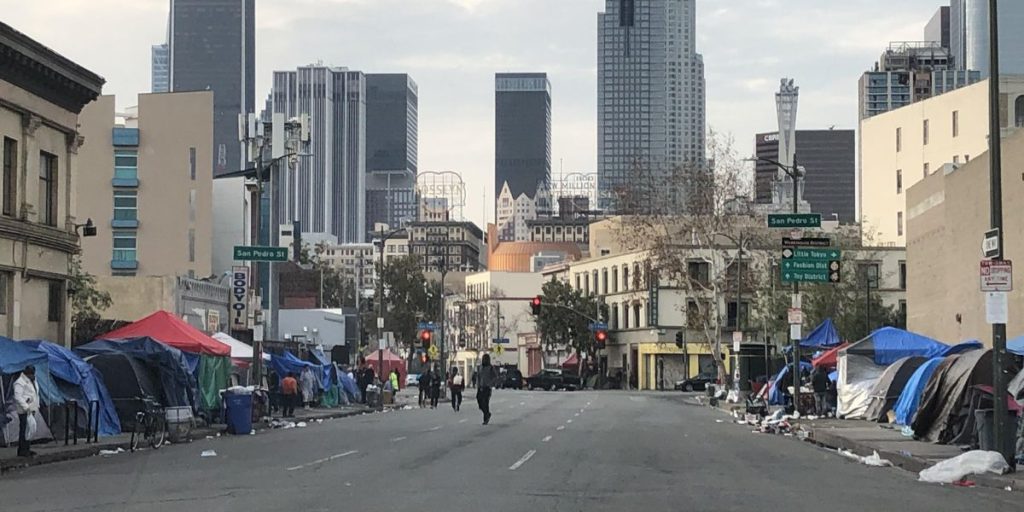Despite its reputation as a glittering metropolis, Los Angeles is a microcosm of the country’s economic diversity and inequality. There are pockets of wealth and prosperous communities, but poverty and other social issues are lurking just below the surface. We will visit some of the poorest areas in Los Angeles today.
Many people in Los Angeles struggle with money issues, even though the city has a very healthy median household income of $76,244. Poverty is clearly not evenly distributed in Los Angeles, as the city has a poverty rate of 16.6%.
Los Angeles has twelve of the city’s poorest neighborhoods listed below.
Skid Row
Situated in the heart of Downtown Los Angeles, Skid Row—officially called Central City East—is a striking representation of the urban poor and homeless. This neighborhood is home to one of the highest concentrations of homeless people in the country, with a shocking poverty rate of 41.8% and a typical household income of only $12,070.
About 4,757 people call Skid Row home, and their struggles with poverty, addiction, and mental health are emblematic of the larger social problems that disadvantaged communities face.
Fashion District
The Fashion District, formerly known as the Garment District, depicts a community where entrepreneurship thrives despite economic adversity. Despite a poverty rate of 25.1% and a median household income of $30,417, this neighborhood is host to more than 4,000 locally owned and run enterprises in the retail and wholesale sectors.
The district’s business prosperity and individual misery are starkly contrasted by the fact that many people experience economic uncertainty, despite the thriving commercial landscape.
South Park
A microcosm of Los Angeles’s economic diversity, South Park has a typical household income of $37,647 and a poverty rate that is 25.1%, just like the Fashion District.
With a typical rent of $1,090, this community faces issues in providing affordable housing for its 13,496 residents. In spite of financial difficulties, South Park cultivates a feeling of community strength as its inhabitants face the challenges of city life together.
Pico-Union
In the face of economic hardship, Pico-Union shines as an opportunity city with a poverty rate of 28.1% and a median household income of $41,042. The presence of five public schools and a public library in this area, which is home to 38,790 varied inhabitants, highlights the significance of education and community empowerment in fighting poverty.
Watts
The famous Watts Towers and rich cultural history of Watts represent the tenacity of the locals during tough economic times. Poverty and unemployment are structural problems in this neighborhood, where the median household income is $43,860 and the poverty rate is 34.7%.
East Hollywood

With a poverty rate of 22.4% and a median household income of $47,004, East Hollywood is a thriving cultural and ethnic melting pot in Los Angeles. This area, which is home to 48,165 people, is known for its many ethnic communities and cultural sites.
Despite the neighborhood’s economic woes, East Hollywood has become a center for innovation and creativity thanks to places like Barnsdall Park and Los Angeles City College.
Southeast LA
Various varied areas in Southeast Los Angeles are dealing with economic inequities; the median household income is $47,764, and the poverty rate is 28.4 percent. This area has 302,016 people living in it, and they’re having trouble finding affordable homes, good schools, and jobs.
Koreatown
The dynamic cultural diversity and economic contrasts of Los Angeles are vividly reflected in Koreatown, which has a poverty rate of 22.3% and a typical household income of $48,064. This community is home to 123,080 people and has a diverse ethnic makeup, with Latinos and Asians making up a large share of the population.
Around 435 people were reported to be homeless in Koreatown in 2022, despite the neighborhood’s thriving cultural scene and busy business sections.
Florence-Graham
With a median household income of $54,241 and a population of 64,787, Florence-Graham exemplifies the strength of the community in the face of economic hardship. Although 22.6% of the population lives in poverty, the many different kinds of people who live here work together to keep parks like Colonel Leon H. Washington, Mary M. Bethune, and Franklin D. Roosevelt Parks in good repair.
El Monte
El Monte, a community about 12 miles east of downtown Los Angeles, is living proof that resilience and creativity can triumph over adversity, even when money is tight. There are 106,907 people who call this area home. They face the challenges of city life head-on, with a median income of $55,609 and a poverty rate of 21%.
Embodying the entrepreneurial spirit and economic vitality of its residents, El Monte is known for being the home of Longo Toyota, the number one auto dealer in the United States by sales and volume. Despite the challenges they face, the residents continue to carve out opportunities for themselves and their families.